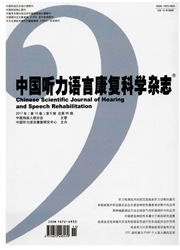

 中文摘要:
中文摘要:
目的:寻找并确定一个中国常染色体隐性遗传性聋小家系的遗传分子病因,探讨该突变在中国人群中的携带情况。方法采集一个常染色体隐性遗传性耳聋小家系(No.1953)样本4例、常染色体隐性遗传性聋患者样本50例、正常听力对照样本208例,临床资料完整;对No.1953家系先证者样本进行全外显子组测序及生物信息学分析,确定可疑致病突变后采用突变位点PCR扩增、Sanger测序在该家系内部、隐性耳聋样本及正常听力样本中进行验证。结果 TMC1基因复合杂合突变c.589G>A和c.1171C>T是No.1953家系的致聋突变;本组隐性耳聋患者及正常人均未发现携带该变异。结论 TMC1基因复合杂合突变c.589G>A和c.1171C>T为常染色体隐性遗传性耳聋家系No.1953的致聋突变,在中国人群中的携带率低,该突变的确定丰富了遗传性聋的突变谱。
 英文摘要:
英文摘要:
Objective To identify causative mutations of autosomal recessive nonsyndromic hearing loss (ARNSHL) in a nonconsanguineous family (No.1953), and provide the basic information for the molecular diagnosis of genetic hearing loss.Methods Blood samples and clinical data of family No.1953, and 50 familial Chinese patients with ARNSHL and 208 ethnicity-matched negative samples were collected. Whole exome sequencing was carried out in two affected siblings, followed by validation in the family.Results Two compound heterozygous, disease-segregating mutations c.589G〉A (p.G197R) and c.1171C〉T (p.Q391X) were identified in TMC1 gene. To exclude the possibility of these mutations were polymorphism, DNA samples of 50 affected and 208 unaffected individuals were analyzed.Conclusion It is concluded that the hearing loss in the family No.1953 is caused by novel compound heterozygous mutations in TMC1.
 同期刊论文项目
同期刊论文项目
 同项目期刊论文
同项目期刊论文
 期刊信息
期刊信息
